

Set-top aerials suck. I've stated that so often here. So let's introduce a little science into the subject - by asking a question.
You can cut to the chase here.
Let's have a shoot-out. In the blue corner, meet a bog-standard Maxview 14-element, like the A1002/W contract aerial. Specs on this are
| Group | channels | elements | forward gain | front/back ratio | Acceptance angle |
| W | 21-68 | 14 | 7.3dB | 22dB | 22.5° |
and it looks like this
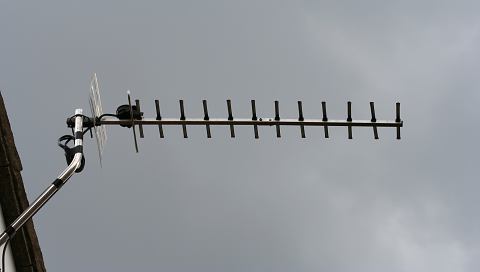
Nothing special, run-of-the-mill aerial. 13 quid from Maplin (code NB15R),
probably about four quid to the trade when bought in bulk. Cable length is about
20m of CT100
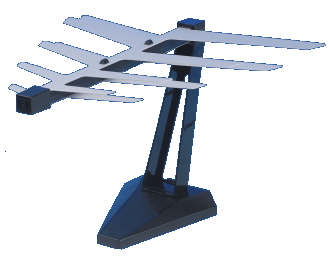 In
the red corner, one Silver
Sensor from Antiference. Antiference are a well-respected company which has
been making aerials for the UK TV market since the 1950s and they don't
generally make junk. I couldn't bear to buy the sort of hopeless junk that
passes for set-top aerials in most places and I'm just not buying an amplified
one at all, so I parted with a tenner for one of these along the principle that
it was best of breed and I had been recommended this as one people had had more
success with.
In
the red corner, one Silver
Sensor from Antiference. Antiference are a well-respected company which has
been making aerials for the UK TV market since the 1950s and they don't
generally make junk. I couldn't bear to buy the sort of hopeless junk that
passes for set-top aerials in most places and I'm just not buying an amplified
one at all, so I parted with a tenner for one of these along the principle that
it was best of breed and I had been recommended this as one people had had more
success with.
Depressingly, I observed
1) that Antiference make a version of this with an internal amplifier (!) and
2) they were cagey about specs.
I couldn't find any, which is unlike them - they come up with the goods for their outdoor range.
| The issues measured with the Silver Sensor are because of the set-top location, they are not a criticism of it as an aerial as such. I selected this model because it is one of the best of breed set-top aerials made by an established aerial company that knows its aerial design. |
Anyway, let's compare. I measured analogue because my signal meter does that well. The difference between aerials will be the same for digital on the same channels. I placed the Silver Sensor about halfway up an upstairs room near the window pointing the same way as the Maxview (which was the optimal position). The height difference between the Sensor and the outside Maxview was about 2m in the Maxview's favour. Signal levels are in dBmV into 75 ohms - add 60 to convert to the more usual dBuV, which is used for the chart. Just for the hell of it I rigged the Silver Sensor in the loft, but the results were poor, similar to the upstairs room [3].
|
 |
So the answer to how much do set-top aerials suck is between 10 and 22dB. The result for channel 5 was so outrageous that I revisited it. By climbing on a chair and holding the aerial to the ceiling I was able to improve this to -15dBmV. I was unable to improve any of the other results by more than 2dB, and not all channels peaked at the same time. So we could recast that to set-top aerials suck by 10 to 16dB - and only if used upstairs. I tried setting in on top of my main TV downstairs. Let's face it - that's where you're meant to put it!. Located on the set-top, set-top aerials suck by 18-29dB. I optimised the downstairs location by aiming the aerial through the centre of the downstairs window which happened to be in the line of the transmitter, in which case the set-top aerial only sucked by 10-18dB.
Let's put this into perspective. The biggest aerial you can commonly get, for extreme fringe areas is something like the Televes DAT 75, offering a 19dB forward gain, a 12dB improvement on my basic Maxview. So to put this into perspective
That's right - you get more improvement by upgrading your set-top aerial to a basic rooftop aerial than you will get upgrading the basic rooftop aerial to the biggest rooftop aerial commonly available for domestic usage in the UK.
Okay - so I really ought to use something better than the Maxview as my analogue is just out of spec on BBC1 and way out of spec on Channel 5.
So in real practical terms, how much do set-top aerials suck[1]?
Before some bright spark suggests I whack in a booster amplifier to make my set-top aerial perform like the aforementioned Televes 75, I did try that, using my trusty Maxview SSB1CRG used in this experiment.
As expected, I still received nothing using the Silver Sensor. Putting the rooftop Maxview into the amplifier input instead brought all channels back. The magic is in the aerial, it is not in the amplifier. I've said it before but I'll say it again
and
Some people don't believe this when presented in engineering voodoo. So here's some pictures -
 |
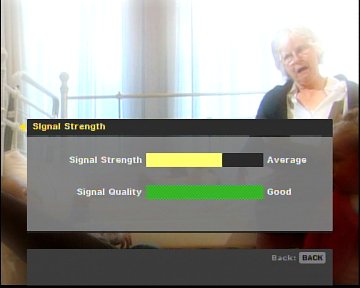 |
|
outside aerial, no amp - pictures |
outside aerial, no amp - Signal Strength |
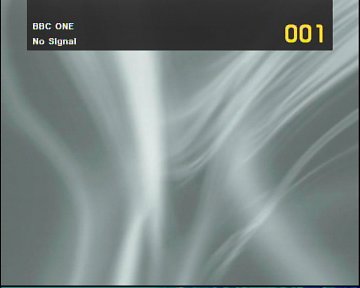 |
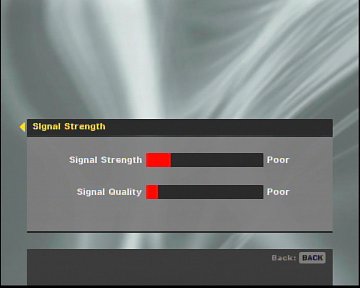 |
|
Set-Top aerial, no amp - no pictures |
Set-Top aerial, no amp - Signal Strength |
 |
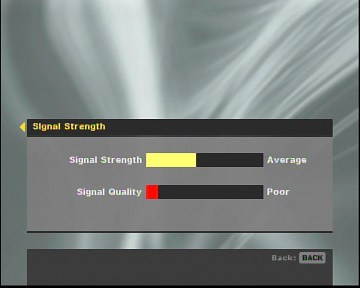 |
|
Set-Top aerial, with amp - still no pictures |
Set-Top aerial, with amp - Signal Strength |
Sharp-eyed readers will observe that the Maxview amplifier did exactly what it said on the tin - signal strength was upped from poor to average. Observe, and weep, those of you who are looking for an easy win, that the amplifier made absolutely no difference to signal quality, which is why I still get no pictures.
Sometimes, however, you are called by the siren song of the Dark Side of the Force. A little devil sits on your shoulder and whispers in your ear
"just a little bit more and you could be in heaven - stick in another amplifier. Go on. I dare you".
And so you fall into the trap of mo'betta , and before you know it your hand reaches out for the spare Maxview PSB2C on the bench. Offering a gain of 9.5dB and a noise figure of 3.5dB, this will no doubt restore Watchdog to my screen when added to the signal path. Hey, maybe I get to eat crow this time, and have to acknowledge my diatribe about what has once been lost is no longer true. Perhaps cascaded boosters make three and a half inches of string perform like a Televes DAT75 on a 100 foot pole, and that the moon really is made of green cheese.
 |
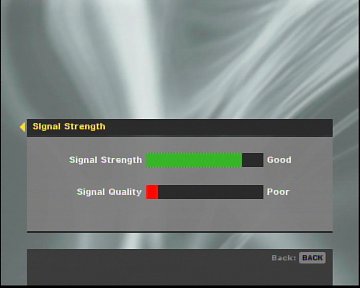 |
|
Set-Top aerial, with TWO amps - still no pictures |
Set-Top aerial, with TWO amps - Signal Strength |
Well, on the upside my signal strength is AOK now. Green bar - high fives all round. Hey - hang on - I still have no pictures. Downside is I've still got virtually no signal quality. Plus I've spent £30 which I could have otherwise spent down the pub. Or on the outside aerial and enough cable to run it into the loft.
Okay, you know the drill, you've heard it all before. I'll say it again
and
By coincidence, soon after writing this, I had the chance to read about a professional analysis of the set-top aerial issue, presented to Ofcom and summariesed in the CAI publication Feedback [4]. They didn't actually call the report "by how much do set-top aerials suck" but they might as well have done.
30% of the UK's 24.4million households use portable aerials. Of those 40%will not be satisfactory for DTT reception.
The DTG 's Peter Marshall and Peter Burnett apparently measured the relative signal levels for some two-storey houses.
Relative to the signal strength for the correct location of the aerial according to the planning guidelines of outside, 10m above the ground and clear of obstructions, they came up with the following relative levels
| Field Strength for outdoor and indoor locations | |
| Reference (outside, 10m above ground, unobstructed) |
0dB |
| First floor rooms | -6dB |
| Ground floor rooms | -16dB |
This is the actual field strength, so you next have to factor in that of the 14 aerials they tested only two provided any gain, the rest were attenuators compared to a dipole (!!!!!). One even oscillated - something only an amplified set-top aerial can do. Just goes to prove the point -
Never, ever, buy an amplified set-top aerial!
So in general I would expect to take a 7dB hit relative to the Maxview. So when you add a 6dB loss in signal strength to a 7dB loss in aerial performance they'd expect a 13dB loss is level compared to an outside aerial for a first-floor room location. I took a 10-16dB hit in level, so I'm pretty chuffed that my results square with the DTG's presumably more rigorous experiments. My 10dB loss on top of that going downstairs also squares pretty well with their values.
What I hadn't realised is how poor the gain of set-top aerials was. This is presumably why if you have to use an indoor aerial, you are better off with a basic 10-14 element aerial designed for outdoor mounting, something like the Maxview I used, perched on top of a shelf. I discovered this by accident as a student and used it in my bedsit days. Of course the aesthetics stink, but you can't have it all in this world.
Selecting and siting your TV aerial